The Mushkin Source 500GB SATA SSD Review: A Value Proposition For An Everyday PC
by Billy Tallis on November 21, 2018 10:00 AM ESTAnandTech Storage Bench - Heavy
Our Heavy storage benchmark is proportionally more write-heavy than The Destroyer, but much shorter overall. The total writes in the Heavy test aren't enough to fill the drive, so performance never drops down to steady state. This test is far more representative of a power user's day to day usage, and is heavily influenced by the drive's peak performance. The Heavy workload test details can be found here. This test is run twice, once on a freshly erased drive and once after filling the drive with sequential writes.
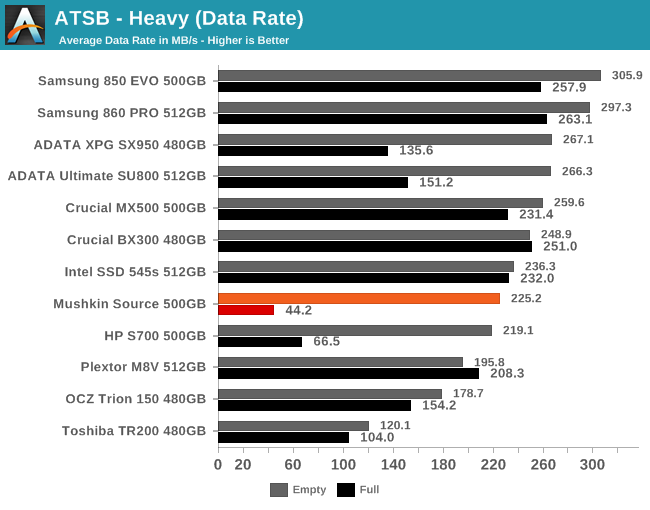
When the Heavy test is run on an empty drive, the Mushkin Source offers performance that is not too far behind many mainstream SATA drives. When the test is run on a full drive, the story is very different, and the Source's average data rate is lower than any of the other drives in this bunch, including the other two DRAMless SSDs.
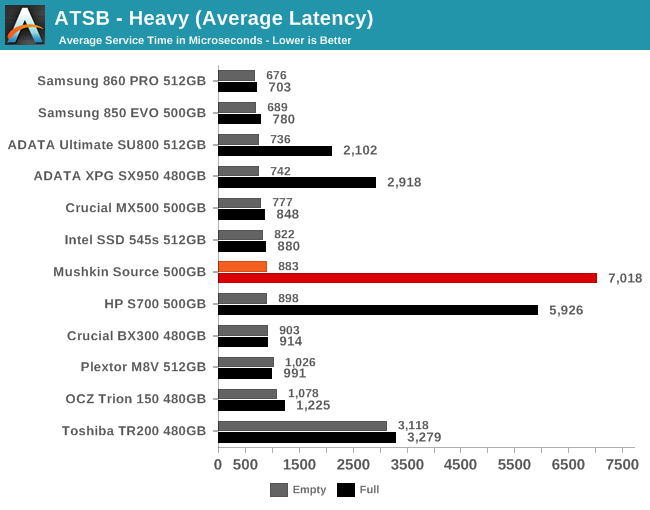

The average and 99th percentile latencies from the Mushkin Source during the Heavy test are reasonable when the test is run on an empty drive, but when the drive is full both scores are worse than either of the other DRAMless SSDs in this bunch.
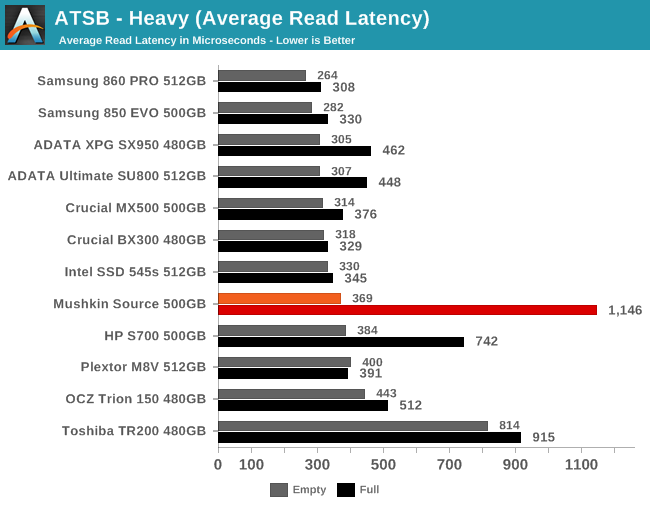
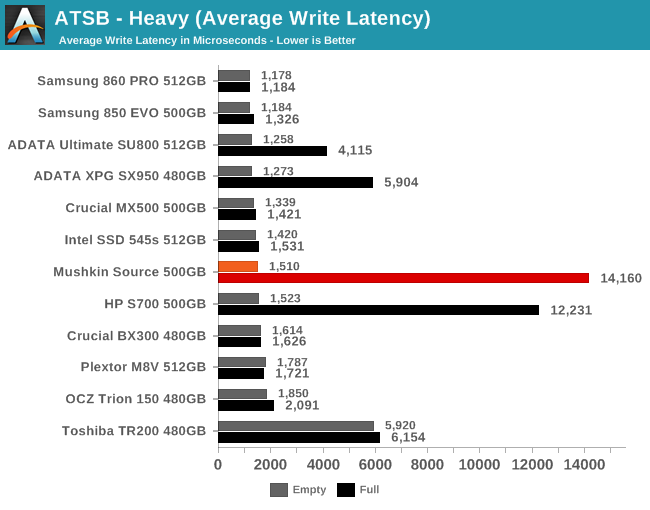
The average read and write latencies of the Mushkin Source are both severely inflated when the drive is full, beyond what the other DRAMless SSDs suffer. But unlike the Toshiba TR200, the Mushkin Source handles both reads and writes well when the drive isn't full.
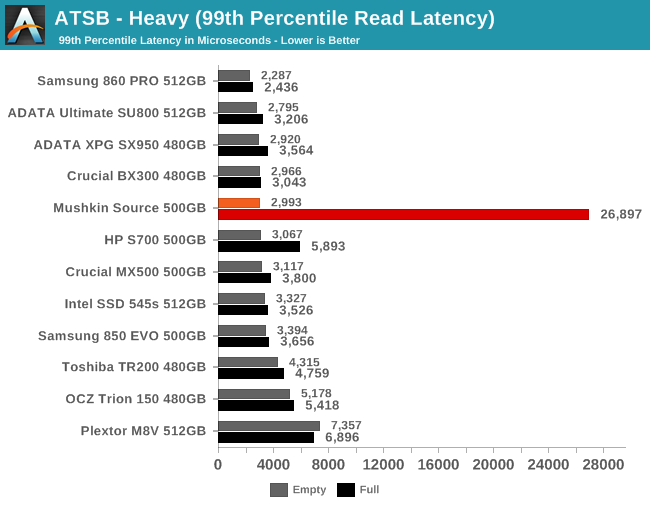
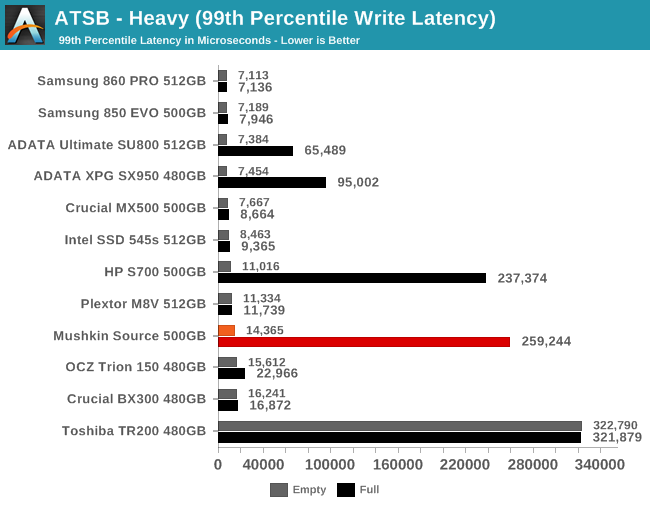
When the Heavy test is run on a full drive, the Mushkin Source has far worse read QoS than any of the other drives; even the HP S700's 99th percentile read latency is no more than twice as high when the test drive is full, but the Mushkin Source's 99th percentile latency gets an order of magnitude worse. For 99th percentile write latency, the Mushkin Source isn't much worse off than other DRAMless SSDs, and at least it does not have the empty-drive performance problems of the TR200.
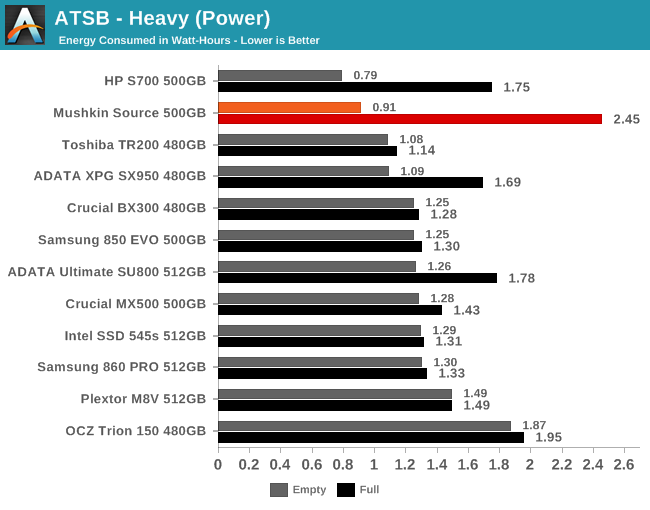
The disparity in performance between full and empty drive test runs carries through to the energy usage measurements. When the Heavy test is run on an empty drive and the Mushkin Source is able to make good use of its SLC cache, the power efficiency is also very good. When the drive is full and bogged down with too much background garbage collection, the energy usage is significantly worse than the rest of the drives in this review.










30 Comments
View All Comments
benedict - Wednesday, November 21, 2018 - link
This needs to be less than 10$/GB to make any sense.deil - Wednesday, November 21, 2018 - link
it might be, wait 3-4 months from initial start. Still its cheapest 500 GB I've seen so far, and that is good sign.Small Bison - Wednesday, November 21, 2018 - link
Yeah, charging over five thousand dollars for a 500GB DRAM-less drive *does* seem like a bit much.excelle08 - Thursday, November 22, 2018 - link
Well you aren't referring to US Dollars, right?😂PeachNCream - Wednesday, November 21, 2018 - link
The scatter plots on pages 6 and 7 may benefit from the addition of color to differentiate storage types. As they stand, they're difficult to extract meaningful data from for a few reasons, but the worst offenders are too many data points in the given space and poor contrast between data types.Billy Tallis - Wednesday, November 21, 2018 - link
The purpose of those scatter plots isn't to enable comparing the highlighted drive against any particular competitor, but to show where it falls relative to the limits of what is possible/normal. The data points for the non-highlighted drives are deliberately low-contrast because their exact value or identity aren't what's important for that graph. They're supposed to blend into a cloud.PeachNCream - Wednesday, November 21, 2018 - link
Hmm, well I wasn't implying that there ought to be individual products highlighted. I was suggesting that using a categorical color in addition to the shape would help with overall visibility. For example, make TLC red, MLC green, and Optane black or something. It would allow us to extrapolate trend-like significance to the categories that were defined in the chart and position the Source among them.Great_Scott - Wednesday, November 21, 2018 - link
SSD prices are so compressed right now that I'm considering getting a Samsung 860 EVO... as the 'cheap' option.There's really no point in getting a 'budget' 2.5" form-factor drive as every brand falls within about a 10% total price range.
Ratman6161 - Wednesday, November 21, 2018 - link
Absolutely. In the SATA space, there is no reason to even look at anything other than the Samsung 860 EVO or the Crucial MX500. The 860 EVO is even cheaper than this piece of junk at the 1 TB level and only $7 less at 500 GB. There is no reason for this drive to exist unless they cut the price...a lot.heffeque - Wednesday, November 21, 2018 - link
Well the BX500 is a pretty decent drive and is somewhat cheaper than both 860EVO and MX500.